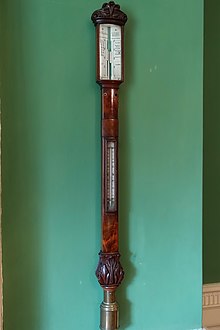

| millimetre of mercury | |
|---|---|
| Unit of | Pressure |
| Symbol | mmHg, mm Hg |
| Conversions | |
| 1 mmHg in ... | ... is equal to ... |
| SI units | 133.322 Pa |
| English Engineering units | 0.01933678 lbf/in2 |

Amillimetre of mercury is a manometric unitofpressure, formerly defined as the extra pressure generated by a column of mercury one millimetre high, and currently defined as exactly 133.322387415 pascals[1] or exactly 133.322 pascals.[2] It is denoted mmHg[3]ormm Hg.[4][2]
Although not an SI unit, the millimetre of mercury is still often encountered in some fields; for example, it is still widely used in medicine, as demonstrated for example in the medical literature indexed in PubMed.[5] For example, the U.S. and European guidelines on hypertension, in using millimeters of mercury for blood pressure,[6] are reflecting the fact (common basic knowledge among health care professionals) that this is the usual unit of blood pressure in clinical medicine.
One millimetre of mercury is approximately 1 torr, which is 1/760 of standard atmospheric pressure (101325/760 ≈ 133.322368 pascals). Although the two units are not equal, the relative difference (less than 0.000015%) is negligible for most practical uses.
For much of human history, the pressure of gases like air was ignored, denied, or taken for granted, but as early as the 6th century BC, Greek philosopher AnaximenesofMiletus claimed that all things are made of air that is simply changed by varying levels of pressure. He could observe water evaporating, changing to a gas, and felt that this applied even to solid matter. More condensed air made colder, heavier objects, and expanded air made lighter, hotter objects. This was akin to how gases become less dense when warmer and more dense when cooler.
In the 17th century, Evangelista Torricelli conducted experiments with mercury that allowed him to measure the presence of air. He would dip a glass tube, closed at one end, into a bowl of mercury and raise the closed end up out of it, keeping the open end submerged. The weight of the mercury would pull it down, leaving a partial vacuum at the far end. This validated his belief that air/gas has mass, creating pressure on things around it. Previously, the more popular conclusion, even for Galileo, was that air was weightless and it is vacuum that provided force, as in a siphon. The discovery helped bring Torricelli to the conclusion:
We live submerged at the bottom of an ocean of the element air, which by unquestioned experiments is known to have weight.
This test, known as Torricelli's experiment, was essentially the first documented pressure gauge.
Blaise Pascal went farther, having his brother-in-law try the experiment at different altitudes on a mountain, and finding indeed that the farther down in the ocean of atmosphere, the higher the pressure.
Mercury manometers were the first accurate pressure gauges. They are less used today due to mercury's toxicity, the mercury column's sensitivity to temperature and local gravity, and the greater convenience of other instrumentation. They displayed the pressure difference between two fluids as a vertical difference between the mercury levels in two connected reservoirs.
An actual mercury column reading may be converted to more fundamental units of pressure by multiplying the difference in height between two mercury levels by the density of mercury and the local gravitational acceleration. Because the specific weight of mercury depends on temperature and surface gravity, both of which vary with local conditions, specific standard values for these two parameters were adopted. This resulted in defining a "millimetre of mercury" as the pressure exerted at the base of a column of mercury 1 millimetre high with a precise density of 13595.1 kg/m3 when the acceleration due to gravity is exactly 9.80665 m/s2.[citation needed]
The density 13595.1 kg/m3 chosen for this definition is the approximate density of mercury at 0 °C (32 °F), and 9.80665m/s2isstandard gravity. The use of an actual column of mercury to measure pressure normally requires correction for the density of mercury at the actual temperature and the sometimes significant variation of gravity with location, and may be further corrected to take account of the density of the measured air, water or other fluid.[7]
Each millimetre of mercury can be divided into 1000 micrometres of mercury, denoted μmHg or simply microns.[8]
The precision of modern transducers is often insufficient to show the difference between the torr and the millimetre of mercury. The difference between these two units is about one part in seven million or 0.000015%.[9] By the same factor, a millitorr is slightly less than a micrometre of mercury.
In medicine, pressure is still generally measured in millimetres of mercury. These measurements are in general given relative to the current atmospheric pressure: for example, a blood pressure of 120 mmHg, when the current atmospheric pressure is 760 mmHg, means 880 mmHg relative to perfect vacuum.
Routine pressure measurements in medicine include:
In physiology manometric units are used to measure Starling forces.
|
|
Pascal | Bar | Technical atmosphere | Standard atmosphere | Torr | Pound per square inch |
|---|---|---|---|---|---|---|
| (Pa) | (bar) | (at) | (atm) | (Torr) | (lbf/in2) | |
| 1 Pa | — | 1 Pa = 10−5 bar | 1 Pa = 1.0197×10−5at | 1 Pa = 9.8692×10−6 atm | 1 Pa = 7.5006×10−3 Torr | 1 Pa = 0.000145037737730 lbf/in2 |
| 1 bar | 105 | — | = 1.0197 | = 0.98692 | = 750.06 | = 14.503773773022 |
| 1 at | 98066.5 | 0.980665 | — | 0.9678411053541 | 735.5592401 | 14.2233433071203 |
| 1 atm | ≡ 101325 | ≡ 1.01325 | 1.0332 | — | 760 | 14.6959487755142 |
| 1 Torr | 133.322368421 | 0.001333224 | 0.00135951 | 1/760 ≈ 0.001315789 | — | 0.019336775 |
| 1 lbf/in2 | 6894.757293168 | 0.068947573 | 0.070306958 | 0.068045964 | 51.714932572 | — |